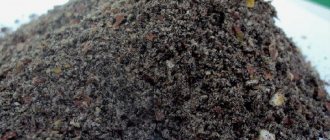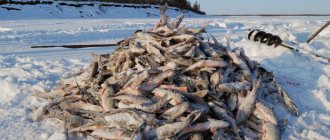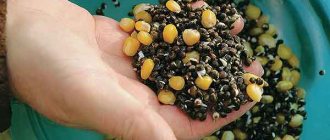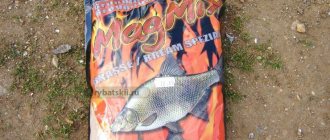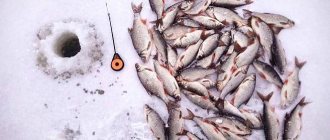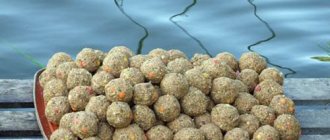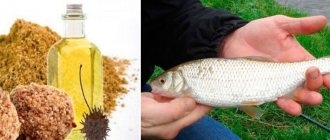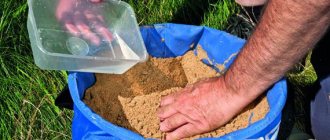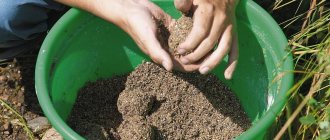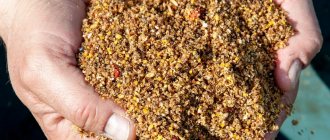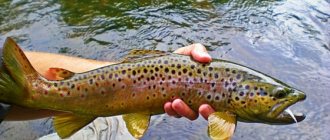When fishing for roach, the bait mixture plays a vital role, since without this element it is impossible to gather a school of fish at the fishing point. Properly prepared bait for roach should not only quickly collect fish in the fishing zone, but also awaken its appetite. The composition of the attractive mixture can be different and depends on the type of reservoir where fishing is carried out, as well as the type of gear used.
Composition of bait for roach
The roach mixture differs from others in its fine grinding, this is due to the fact that the roach prefers to feed not from the bottom, but in the water column and shows an increased interest in slowly falling particles. Food consisting of large fractions will quickly sink to the ground and attract bream or crucian carp. Roach bait should create an appetizing column of turbidity when diving, in which the fish will find the bait attached to the hook. To create such an effect, the composition must contain components that quickly dissolve in water. The following ingredients are used to feed roaches:
- breadcrumbs;
- finely ground wheat bran;
- corn flour;
- various cereals;
- oatmeal (finely ground oatmeal);
- sunflower, hemp and coconut cake;
- powdered milk;
- baby food;
- various types of sweet cookies.
In addition, depending on certain fishing conditions, animal components such as bloodworms, maggots or worms may be included in the bait. The composition must contain those components that are used for fishing. If a fisherman uses oat grains as bait, then at least 10% oatmeal must be included in the bait mixture. When fishing for bloodworms, you need to add at least some live larvae to the complementary food. This is done so that the fish quickly gets used to the taste and smell of certain ingredients and more boldly takes the bait offered to it. All ingredients included in the composition must be fresh and free of foreign odors that repel roaches from the fishing point.
Making bait for bream with your own hands
- The composition of any bait must include porridge, cooked from one or another cereal, or from a mixture of cereals. The porridge is cooked over low heat, making sure that it does not burn under any circumstances. Also, you should not boil it - the grains should remain intact.
- Add dusty components to the bait (cocoa, dough, milk powder) - a cloudy, aromatic cloud will attract the attention of the bream. Just don’t overdo it with their quantity - an excessive amount of turbidity will attract a lot of small fish.
- If you plan to add red dung worms to your bait, keep in mind that they must first be cleaned. This is done as follows: place the worms in a jar of river sand for a couple of days. Then put the leaves of aromatic herbs (mint, thyme) into this jar; a crushed clove of garlic will also come in handy. As a result of such procedures, dung beetles will acquire an appetizing appearance and smell for bream.
- Bream is a lover of sweets, so it is advisable to add sugar, molasses, crushed cookies, and caramel to the bait.
- It is important not only to choose the right ingredients, but you also need to know how to knead the whole thing. The batch is done on the pond, before fishing begins. The prepared ingredients (except for porridge and flavoring) are slightly moistened with water from a reservoir and mixed. Wait until the mixture gets wet and starts to stick together (this will take a few minutes), then add porridge or crushed cereal and flavoring to the complementary food.
- When fishing in a place with a good current, add more astringent ingredients (clay, flour, oatmeal) to the bait.
Bait for roach and various tackles
For fishing for roach, float and feeder tackle are often used. Many fishermen make the mistake of using the same bait mixture for these types of fishing, since bait for bottom and float fishing differs from each other in several performance characteristics.
Bait for float fishing
The roach mixture for float fishing in still water should be very light. When moistening it, add a minimum amount of water to the container. The optimal level of moisture will be when the molded ball disintegrates when it hits the water. After breaking the ball, the particles slowly sink to the bottom, attracting roaches. If the bait is over-moistened, the ball, without breaking on the water, will quickly sink to the bottom and will not be able to collect roach in the fishing zone.
Since the amount of bait that is thrown into the fishing point is quite large, you should not get carried away with adding excessive amounts of flavorings. The components included in the roach bait themselves have an attractive aroma for fish.
If we are talking about float fishing for roach in the current, then the principle of operation of complementary foods changes. It consists of heavy soil consisting of earth, clay and sand. The soil keeps nutrient particles from being quickly carried away by a directed flow of water. Fishing in the current involves the formation of dense bait balls, which will quickly reach the bottom and will be eroded by the current for several tens of minutes. The food particles washed out of the balls will gradually collect the roach in the feeding area.
Groundbait for bottom fishing
The mixture for feeder fishing for roach must be active. Having sunk to the bottom, the bait stuffed into the feeder does not just lie on the bottom soil, but actively releases food particles that attract fish, creating a cloud of turbidity around it. This effect can be achieved by adding various ingredients that have buoyant properties:
- dry coconut flakes;
- ground seed peel;
- medium-ground oat flakes.
These ingredients should be added only after the complementary foods have been moistened, when the mixture has completely absorbed the water. Seeing constantly floating particles of food, the roach will definitely become interested and approach the feeder.
The volume of the feeder is small, so a limited amount of food is supplied to the fishing site. When a large flock approaches, in which there are large individuals, the mixture delivered to the point will be quickly eaten, and the roach will leave. To prevent this from happening, feeder baits include a large amount of flavoring. Even after the fish has completely eaten the mixture, a fragrant trail remains in the water, which prevents the school from leaving the feeding area. In addition, the bottom soil is impregnated with aromas, which also helps to retain the roaches in the fed zone.
Bream fishing gear
The main equipment for catching bream is a feeder.
Choosing a feeder rod If you haven’t had time to do feeder fishing yet, then hurry up, in it you will find much more excitement in fishing than with classic bottom tackle, since this rod transmits bite signals to you much more accurately, and accordingly this will affect your catch. Choosing a feeder rod for beginners.
In areas where promising areas are located a short distance from the shore, fly rods can also be used. In this case, the length of the rod should be at least five meters, but it is better to use a seven-meter rod. Bream is a cautious fish, so an extra couple of meters of distance between it and the angler will not be superfluous. In this regard, a match rod would be preferable, allowing the angler to fish comfortably even at a twenty-meter distance.
Fishing from a boat is much more effective, but the period in question falls during the spawning ban on fishing from watercraft, so it is not possible to go out on the water everywhere. If there is the possibility of fishing from a boat, then it makes sense to look for bream in irrigation areas with fields of water lilies and egg capsules. At depths of up to four meters it is convenient to use a long fly rod. If the depth at the fishing spot is less and the water is clear, then the fishing distance will have to be increased. In this case, it is better to catch bream with a feeder. Catching with a match will also be quite effective in the situation under consideration.
Feeder equipment for river fishing Before you buy a feeder for river fishing, it is worth considering that the choice of rod characteristics will be based not so much on the requirements for casting range, but on the ability of the blank to work with heavy feeders that can hold the equipment in a strong water flow .
Bait and seasons
The taste preferences of roaches may vary depending on the season. The fisherman needs to be able to choose a bait mixture that will attract fish both in warm summer and cold winter water.
Bait in spring
A properly prepared mixture for fishing in early spring should not include a large number of ingredients. In cold water, roaches are very wary of any foreign odors, so cakes and flavorings should be completely excluded from the composition. To prepare the best bait for roach, which will work flawlessly in early spring, the angler will need:
- 1 kg breadcrumbs;
- 0.2 gr. powdered milk or baby food;
- 0.4 kg finely ground wheat bran.
Since in cold water roaches are often caught using maggots and bloodworms, these animal components must be included in the composition in small quantities. You can add not only live but also dead bloodworms to complementary foods. Dead larvae sink more slowly and are better at attracting inactive fish. If spring fishing takes place in a stagnant reservoir with clear water, then the bait composition should be colored dark with food coloring, since in cold water the fish may be afraid of light spots of bait. Since the fish is quite passive, the angler should limit the daily amount of bait, which should not exceed 2 kg of dry mixture.
When the water is heated above 12 degrees, cakes and a small amount of flavorings can be included in the composition. As the water warms, the fish begins to show interest in vegetable baits, which means adding oatmeal and corn flour to the bait. The daily amount of feed can be increased to 3 kg.
Bait for bream and roach
Let's look at the features of preparing bait for catching bream and roach. What is the difference between these types of mixtures? What is the significance of the various components and how should they be used correctly for the bait to work more efficiently?
Roach or bream?
Let’s not dwell on simple things - like the differences between roach and bream mixtures in many respects: color, fractions, aroma, size, composition. Everything is clear and simple, but only at first glance - roach is depicted on the packaging, which means the mixture is for this fish. However, for people who have been practicing sports float fishing for a long time, sometimes the line between exclusively bream baits and purely roach baits disappears. Ready-made mixtures used to attract these fish can sometimes get along well when mixed and complement each other perfectly. The main thing is to understand what you need to get from the mixture. And, of course, have extensive fishing experience and knowledge about the habits and preferences of fish in a particular body of water.
It should immediately be noted that fish behave differently in different bodies of water. Therefore, it is impossible to adapt the theory of feeding to 100 percent of all reservoirs.
What's the point?
It is technologically possible to obtain mixtures with different aroma, color, individual ingredients in the composition, and grinding fraction, but it is difficult to ensure the percentage of “flour” admixture in the process of crushing bread or corn. The fact is that no matter how much the manufacturer of factory mixtures or homemade baits wants to prepare a mixture that is unique in physical parameters, it will still turn out something in between. The first myth says this: homemade or purchased bait for roach or bream is an average mixture according to physical parameters, in which only a small number of indicators are specified, often relating to the aromatization of the bait, which determine its belonging to the species.
The second myth is a strict division according to taste preferences of roach and bream. We must remember that these fish are from the carp family. Often in reservoirs they are competitors for food; they have an almost identical “set of products”.
First conclusion
As already mentioned, baits are divided into roach and bream, sometimes conditionally. Bream are always interested in roach baits, and roaches are always interested in bream baits. For example, the Sensas range of baits includes one interesting mixture “GrossGardons”. This is a mixture to attract roaches. However, most sports fishermen use it when fishing for bream, both in pure form and with the addition of bream mixtures, not expecting that roach will be in the bycatch, counting only on bream.
Differences
Bream and roach mixtures differ in flavor, color and components.
The color of the bait is only relevant for catching bream. As a rule, bright baits (red, yellow) are used, which are clearly visible in the water. The roach is very attentive to bright spots on the bottom, trying to stay away from them. The bream behaves calmer. To attract both roach and bream, it is necessary to use dark mixtures. Brown or dark mixtures are versatile.
Additives to bait
Modern trends in fishing are dictated by several rules. One of them is the use of ready-made baits, when the first thing to worry about is the method of mixing, changing the color, and additional aromatization of the baits. However, less often is the addition of such useful additives as hemp, flax, and oil cakes, which are prepared independently, to branded baits. Such additives can increase the effectiveness of bait by 10 percent.
It should be noted that additive No. 1 for preparing bream baits is roasted flax. And roaches like ground and fried hemp.
Non-traditional additives also include roasted and ground sunflower seeds, powdered sugar, cake, and peanuts. Some anglers add ground cashew nuts, hazelnuts and walnuts, pumpkin seeds and many other ingredients to their bait.
Kneading
Naturally, the method of mixing mixtures is determined by the fishing conditions: the absence or presence of a current. This means that the stronger the current, the more moist the mixture becomes. But you need to take into account some nuances that affect the attractiveness of bait. The unique formula for mixing bream and roach baits can be formulated as follows: bream bait is the minimum appropriate moisture + a lot of muddy substances, if this is appropriate in certain fishing conditions. The dam mixture is the maximum appropriate moisture + a minimum of clouding substances.
When is mixing possible?
It was mentioned above that in certain situations, roach and bream baits mix well. It is worth mentioning that in 70 percent of cases at competitions, anglers mix baits, making them universal, because on many fishing trips the presence of bream in a reservoir does not exclude the bycatch of roach. You can use combined bait, mixing 1/3 roach and 2/3 bream mixtures. You just need to pay attention to the fact that the smells of these mixtures match: spicy aromas need to be mixed with spicy ones, sweet ones with sweet ones, etc.
Mud and its lovers
You should know that roach and bream in many cases react differently to the turbidity created by bait mixtures. Bream are typical fans of muddy baits, and roach, although small in size, are not fans. But the presence of turbidity in the finished bait does not mean that the mixture is immediately classified as bream or roach. The presence of turbidity in mixtures can be considered an enhancement of roach or bream characteristics.
First example. For bream fishing, five kilograms of bait were prepared, which consists of three kilograms of exclusively bream bait and two kilograms of roach bait. Such a mixture attracts bream to the fishing point, and the additional addition of a muddy substance to the final bait (for example, certain types of soil or a lake mixture) allows you to create an attractive effect. And instead of 5 bream, seven or ten will swim up. Therefore, the skill of fishermen lies precisely in the ability to work with individual ingredients of bait.
Second example. Roach fishing. Working bait for catching roach can be made by mixing four kilograms of roach mixture with a kilogram of hemp. When adding a turbid inert substance (for example, loam) to such bait, the aromatics and its color will not change, but this may negatively affect the attractiveness of the roach bait, or rather due to turbidity.
Second conclusion
The bait itself attracts fish, but by adding various components, additives, and changing the proportions, it is possible to obtain much more interesting baits. The main thing is to know and understand what results can be achieved by performing certain actions with the constituent ingredients of bait.
Do-it-yourself bait for roaches in summer
Summer time is the most active time for using plant baits. Since roach almost completely switches to feeding on algae, it responds well to any plant mixtures. During this period, the composition should be rich, include a large number of different cakes and have a pronounced sweet taste and aroma. To make summer bait for roach with your own hands, the fisherman will need the following ingredients:
- 2 kg breadcrumbs;
- 0.5 finely ground wheat bran;
- 0.5 kg corn flour;
- 100 gr. sunflower, hemp and coconut cake;
- 300 gr. powdered milk or baby food;
- sweet-smelling flavoring.
After mixing the dry ingredients, you need to add flavoring to the complementary foods. Dry flavoring must be mixed with other ingredients until moistened. If a liquid version is used, it must first be diluted in water, which will moisten the mixture. To give the bait a sweet taste, add a little sugar or beet molasses to the mixing water.
The same recipe for summer bait for roach can also be used for feeder fishing, only in the latter case you will need to add 2 times more cake, as well as dry coconut flakes or medium-ground oatmeal. The amount of flavoring can also be increased, exceeding the volume recommended by the manufacturer for addition by 1.5 times.
Bait in autumn
In the fall, in September and October, the roach again switches to feeding on invertebrates and reacts only to those bait mixtures that contain animal components. If at the beginning of autumn active summer feeds are still working, then with the October cooling of the water, the fish are extremely wary of strongly flavored compounds that contain a lot of cakes and heavy particles.
The autumn change in water temperature makes the fish passive and forces the angler to be very careful in the selection of bait components. In cold autumn water, the best results will be shown by the same option that worked in early spring. The color of the complementary food must be dark. The amount of supplementary feeding must be strictly regulated by throwing one small ball at a time at the fishing point. The fisherman must constantly monitor how the fish reacts to supplementary feeding. If the bites have stopped, then you should temporarily stop feeding the roach.
Groundbait for winter
Winter roach fishing is also not complete without feeding. In winter, the daily amount of bait is reduced to 0.5 kg, which is associated with a slowdown in the vital processes of fish. A significant part of the mixture consists of animal components. To make bait for roach that works in winter, the fisherman will need:
- 0.4 kg breadcrumbs;
- 50 gr. dried daphnia;
- 50 gr. aquarium food;
- 200 gr. small bloodworm.
The dry ingredients are mixed and poured into the winter feeder. A few small bloodworms are placed on top of the dry food. The fisherman opens the feeder 50–70 cm from the bottom, thereby creating a feeding spot on the bottom soil. To quickly attract fish to the fishing point, you can crush part of the bloodworm with your fingers before lowering the feeder into the hole. The crushed bloodworm will give juice, which will quickly collect the roach under the hole. Good results are obtained by using liquid bloodworm extract, which can be purchased at a fishing store. This liquid is poured over the mixture poured into the feeder.
Bait recipe for bream based on crackers
This spring bait recipe for bream is designed to prepare a mixture that can be used in strong currents, because most of the components have excellent adhesive properties.
Ingredients:
- breadcrumbs – 1000 g;
- corn flour – 100 g;
- steamed millet (without husk) – 200 g;
- Hercules flakes - 100 g;
- crushed sugar cookies – 200 g;
- granulated sugar – 50 g;
- wheat bran – 300 g;
- maggot (fodder) – 50 g;
- chopped cumin or coriander – 1 tsp.
This bait for bream in the spring is made with your own hands directly on the pond using water from it. The only thing is that the millet will have to be cooked in advance. Boil it in boiling water for 10-15 minutes, avoiding boiling. After this, the millet is washed 2-3 times so that it does not stick together.
Technique for feeding roaches
Feeding technique is no less important than properly prepared mixture. Feeding in a stagnant pond consists of starting feeding and subsequent supplementary feeding. Starter feeding is a one-time casting of 5–7 balls of bait the size of an orange at the fishing point. The balls are thrown exactly into the place where the float will be.
After the starter feeding, you will need to carry out regular additional feeding, tossing one small ball every 2-3 minutes. This supplementary feeding technique allows you to create a continuous column of bait suspension in the water column, which keeps the fish in the fishing spot for a long time.
Spring porridge recipes for various types of fish
Porridge for crucian carp
Crucian carp is a fish that can be found in almost any body of water. There is even such a category of fishermen as “crucian fishermen”. Crucian carp, like all cyprinids, may prefer corn porridge. It is prepared as follows:
- Take a pan and pour water into it and add corn grains, adding a teaspoon of sugar.
- The corn is cooked for at least 2 hours, with occasional stirring.
- Once ready, let it cool to room temperature. It is then passed through a meat grinder and mixed with animal feed.
- To make the porridge have an attractive aroma, you can add drops of anise, vanillin or chopped garlic to it.
Porridge for carp
A feeder like a spring is also used for carp fishing. Catch porridge can be prepared according to this recipe:
- 800 grams of peas are poured into a saucepan with water and cooked until smooth.
- While the porridge is cooling, take a bag of fried seeds and pass it through a meat grinder.
- 400 grams of semolina are gradually added to the cooled porridge with constant stirring.
- The porridge is stirred until it acquires the consistency of hard dough. After this, the crushed seeds are poured here.
- Finally, the whole mass is thoroughly mixed again.
The resulting porridge can be divided into several parts and placed in plastic bags. The porridge is stored for no more than 24 hours, after which it loses its attractive properties. In this regard, such porridge should not be prepared for long-term storage. It is suitable for one-time use.
Porridge for bream
Cooking porridge for bream does not have any special features, it just uses pearl barley, and it is prepared like this:
- Pour 3 glasses of water into the container and put on fire.
- When the water boils, pour several glasses of pearl barley into it. The pearl barley is cooked until it has absorbed almost all the moisture.
- Millet cereal, a tablespoon of vegetable oil and a little vanillin are also added here.
- The porridge is cooked until the remaining moisture disappears and small bubbling holes appear on the surface.
- The fire is turned off, and the porridge is removed from the stove and covered with a lid. The porridge should sit for half an hour.
- After the porridge has brewed and cooled, semolina, barley grits and corn grits are added to it, about one glass each, depending on the consistency.
- The porridge is thoroughly mixed.
Flavorings for bait
Roach reacts well to odors, so the use of flavorings in bait mixtures is completely justified. During the warm season, the following scents work best:
- caramel;
- vanilla;
- cinnamon;
- tutti-fruti;
- chocolate and fruit aromas.
In cold water, pepper, garlic and curry flavors are used. If specialized flavorings are used for bait, then they must be added in the quantities indicated on the packaging. You need to be extremely careful with odorous substances intended for confectionery purposes, as they have a high concentration. It is very difficult to overdo it with natural flavors, so they are preferable in most cases.
Pros and cons of store-bought bait
Roach bait can be made independently or purchased at a fishing store. Store-bought bait for roach has several advantages:
- balanced composition, the effectiveness of which has been tested by professional fishermen;
- the calculated amount of aromatic substances eliminates the need to buy a flavoring agent;
- The packaging always indicates what type of fish the mixture is intended for, which is very convenient for most fishermen.
The disadvantages of purchased products include the fact that really good mixtures are not cheap. On the shore of a reservoir, a fisherman may encounter a situation where the purchased option (due to its performance characteristics) turns out to be useless. The factory mixture has a limited shelf life, so when purchasing complementary food in a store, an angler runs the risk of buying an expired product that is unsuitable for fishing. Experienced fishermen prefer to make bait recipes for roach with their own hands and get a lot of pleasure from it.
